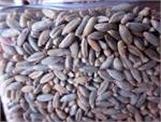
3 Types Of Rye
- White Rye is the lightest in color because it has all of the bran and germ sifted out. All that is left is the white endosperm. White Rye is higher in starch and lower in protein.
- Light Rye has more bran so it's darker in color but the germ is still removed.Dark Rye has the most bran hence the color.
- Dark Rye has the most bran hence the color.
Rye is the only grain that has bran not only on the outside of the kernel but bran with in the endosperm. This is important because it effects the properties of the flour when you are using it. Since it has more bran it is slow to take up liquids, which makes the dough very stiff when you first start working with it, especially if you are using a direct dough. Rye is also has half the gluten compared to wheat so it must be mixed with a higher gluten flour like a hard red or hard white if you want a light high loaf.
Rye also has a different type of protein called “pentosan”, Pentosan protein is not like gluten which are like elastic bands, pentosan is brittle when stretched which makes the rye dough very fragil to work with and difficult to achieve a high loaf. Pentosan protein also likes moisture so rye will require more liquid per cup than a hard red or hard white flour. Also when the proteins absorb the liquids they become slimy which is a different feel than a wheat dough to work with.
Rye is more alkaline than wheat that is why many recipes call for a sour dough starter which balances the alkaline with acid. If the recipe does not call for a starter, many times about 1 T. per loaf of vinegar is added to the dough.
Health Benefits
- Loose weight...Since it has more fiber it leaves you with a full feeling not only do you eat less but your body absorbs less calories since there is more bran and it goes right thru you.
- Best choice of diabetics...Your body has to work to bread down the complex carbohydrates which keeps your blood sugar more even. The glycemic index for a dark rye is 33 compared to wheat at 45 anything below 50 is what you want to target.
- Not only is there more bran in Rye but the bran is better for you. The bran has a chemical called lignans which lowers the PH in the colon and acts like a natural antibiotic. It is also been shown to lower cancer risks in women like breast and ovarian and benefit prostate health in men.
 RSS Feed
RSS Feed
